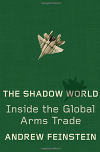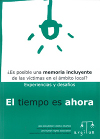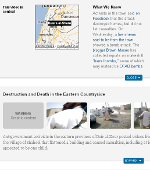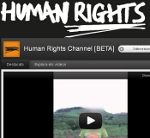Recommendations
More Recommendations
-

The Shadow World
Andrew Feinstein. The Shadow World: Inside the Global Arms Trade. Farrar, 2011.
Andrew Feinstein was a member of the African National Congress until it refused to investigate a corruption case related to an arms sale to South Africa. Following this experience, he has investigated the behind-the-scenes of the global arms trade and this is exactly what he explains in this book. After an exhaustive search of declassified documents, Feinstein details the specific connections among politicians, arms manufacturers, arms dealers and armies around the world.
Each of the arms sales analyzed involves government to government transactions, but also the deals that take place in the shadow world of illicit trade and, particularly, the frequent relations between often these two sides of the same coin. Operations on the five continents in which several people of the United States and Britain play a crucial role, not always reaching the mass media and, therefore, leaving the public opinion unaware of what's going on.
One of the values ??of this research is that it specifies each of the phases of the arms trade process, with the obvious consequences that a system of widespread corruption has for democracy, socio-economic development and human rights violations worldwide. The stories it contains, written with force and precision, exhort us to continue to push for an international arms trade treaty as soon as possible.
J.A.
-

El tiempo es ahora
El tiempo es ahora. ¿Es posible una memoria incluyente de las víctimas en el ámbito local? Experiencias y desafíos. Asociación Pro Derechos Humanos Argituz, 2012.
The report El Tiempo es ahora ("The Time is Now"), published by the Argituz association, provides an analysis of the possibilities of constructing an inclusive memory for the victims of terrorism and politically motivated violence, as a consequence of the violent conflict in the Basque Country.
The text is structured in three parts. The first part reviews the international experience in relation to the importance that measures of recognizing responsibility and symbolic actions of collective memory have for victims. Part two analyzes the experiences developed within the Basque territory, studies their problems, their impact and their difficulties, and compiles the considerations of the protagonists. The third part deals with lessons learned and the difficulties for an inclusive memory in the Basque Country, establishing some criteria which take into account the relationship with the victims, the projects developed at a local level, as well as the challenges, so that this inclusive memory becomes a mechanism of recognition and violence prevention in the present and future.
In a context marked by the end of ETA violence and by a political normalization which allows for participation in politics and for a life free of threats and fear, the recognition of responsibility and of memory is one of the steps pending in the process of reconstructing the relations fractured by violence.
E.G.
-

Watching Syria's War: online videos put in context by the NYT
http://projects.nytimes.com/live-dashboard/syria
Every day new, often shocking, videos appear online about the on-going violence in Syria. Doubts can often be raised, however, about the reliability of the information provided and certain videos are clearly used for propaganda purposes. Given that "what you see does not necessarily reflect exactly what is going on", the New York Times (NYT) has set up the project Watching Syria's War, aiming to create some clarity out of the chaos of online material.
As videos uploaded by the people in Syria present their own particular views on the conflict, Watching Syria's War, which is run by journalist J. David Goodman, does not present videos as the truth, but rather puts them into context. The web explains "What We Know" and "What We Don't Know" about the events shown in the videos and provides links to related online footage, thereby always stressing that, even if it is believed that the images are correct, it is not the NYT that has made these videos, nor that it can take any responsibility for them. Moreover, Watching Syria's War tries to convert the videos into interactive stories, stimulating discussion by sending out Tweets after every posting.
This project can certainly be welcomed, particularly given the difficulties that professional journalists face when trying to cover stories in Syria. Self-made online videos clearly cannot replace professional war journalism, but uploading videos to YouTube is an essential part of telling the story of the Syrian rebellion. And it certainly is a story which needs to be told.
L.v.T.
-

The new Human Rights Channel on YouTube:Increasing the impact of human rightsactivism
http://www.youtube.com/humanrights
How to make previously unheard voices heard? The new Human Rights Channel on YouTubeprovides a helping hand by creating a platform for recording, visualising andcontextualising under-reported stories on human rights issues.The channel, which also incorporates footage of human rights organizations that already share their work on YouTube, helps people find their way through the huge amount of raw citizen-videos that are put online each day.Featured stories include topics like the Arab Spring, the conflict in Sudan and the use of cluster munitions, but also local cases of police brutality, discrimination, gender-based violence, or socio-economic justice.
For this project, which was launched in May 2012, YouTube works together with two key partners.The videos are provided with context by WITNESS, an international NGO,co-founded in 1992 by Peter Gabriel, Human Rights First and the Reebok Human Rights Foundation, whichpromotes the use of video amongst human rights defenders. Verification ofthe videos is done by Storyful, a social newsgathering operation specialised in separating actionable news from merely"noise"of the Internet.
The Human Rights Channel also providesuseful support and insights fromexperienced video activists, includingtools and informationthat can turnany citizen into an effective human rights defender and a five-part video seriesonhow to film protests, conduct videos and protect both the camera person and the people shown in the video.The channel is also available on Google+, so thatothers can participate in the discussions, share material, or find partners for their human rights projects.All in all, it is certainly worth a look.
L.v.T.